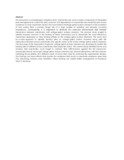Molecular Modelling of Insecticide Binding Sites of the Voltage-Gated Sodium Channels of Fall Armyworm, (Spodoptera frugiperda)
Date
2021-08-05Author
Gichere, Savinda Njeri
Khamala, Alfred Alinda
Ambutsi, Michael
Khakame, Kakai Shem
Okoth, Patrick
Metadata
Show full item recordAbstract
Fall armyworm is a polyphagous migratory pest. Insecticides are used as major components of integrated pest management to control the pest, however, full dependence on insecticides has made the pest evolve resistance to most insecticide classes.The involvement ofvoltage-gated sodium channels in the excitation of cells makes them a primary target site of a large number of synthetic and naturally occurring neurotoxins. Consequently, it is imperative to delineate the molecular determinants that mediate interactions between insecticides with voltage-gated sodium channels. The present study sought to identify residues involved in the binding of these insecticides and to demarcate the most efficacious insecticides depending on their binding affinity to the voltage-gated sodium channels. The study took an in-silico approach to identify docking sites on voltage-gated sodium channels along with the interactions between known insecticides and specific amino acids on the voltage-gated sodium channels. The homology of the Spodoptera frugiperda voltage-gated sodium channels was developed to predict the binding sites of different known insecticides that target the insect. The current study identified amino acid residues that insecticides could target to enhance their effectiveness against the fall armyworm. Insecticides that do not target voltage-gated sodium channels also showed interactions with this channel, indicating the possibility of a different mode of action that could be confirmed by experimental studies. Our findings can direct efforts that monitor for mutations that result in insecticide resistance given that new interacting residues were identified. These findings can enable better management of resistance when it develops.
URI
https://doi.org/10.21608/EAJBSA.2021.187543https://eajbsa.journals.ekb.eg/article_187543.html
http://ir-library.mmust.ac.ke:8080/xmlui/handle/123456789/1796
Collections
- Gold Collection [969]

